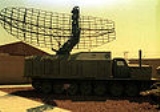
P-40 radar
Encyclopedia
The P-40 "Armour" or 1S12 (also referred to by the NATO reporting name
"Long Track"in the west) is a 3-D UHF radar
developed and operated by the former Soviet Union
.
.
In 1965 the P-40 gained the GRAU
designation 1S12 as it was adopted as the target acquisition radar of the 2K11 Krug mobile anti-aircraft defence system.
The P-40 was developed by Scientific Research Institute #208 GKRE, which later became known as NIIIP of Minradioprom, OKB-588 (later Lianozovskiy Electromechanical Plant, LEMZ) also assisted in the production of the prototype.
Between the 1966 and 1968 the radar was upgraded, increasing the range of the system. Later, between 1969 and 1970, the radars range was again improved in addition to achieving better reliability.
 The P-40 was the first high-mobility radar to enter into service with the then new tactical anti-aircraft forces of the Soviet armed forces
The P-40 was the first high-mobility radar to enter into service with the then new tactical anti-aircraft forces of the Soviet armed forces
.
The P-40 used the AT-T artillery tractor with tracked chassis, fitted with a 12-cylinder 4-stroke diesel engine
with an output of 342 kW (465 hp) and producing a top speed of 55 km/h. The P-40 had a crew of 6 and a total weight of 35 tons, the radar being powered by a gas turbine running 400 Hz generator.
The radar uses an open frame truncated parabolic antenna with a stacked antenna feed. The radar antenna is mounted on the truck used to transport it giving excellent mobility, the radar capable of being folded for stowage during transit. Azimuth was determined by mechanical scanning while the angle of the target is determined from within which beam of the antenna stack the target is detected, the radar does not carry a secondary antenna for IFF
.
NATO reporting name
NATO reporting names are classified code names for military equipment of the Eastern Bloc...
"Long Track"in the west) is a 3-D UHF radar
Radar
Radar is an object-detection system which uses radio waves to determine the range, altitude, direction, or speed of objects. It can be used to detect aircraft, ships, spacecraft, guided missiles, motor vehicles, weather formations, and terrain. The radar dish or antenna transmits pulses of radio...
developed and operated by the former Soviet Union
Soviet Union
The Soviet Union , officially the Union of Soviet Socialist Republics , was a constitutionally socialist state that existed in Eurasia between 1922 and 1991....
.
Development
The P-40 started development in 1960 and by 1962 the radar had completed state trails and in 1963 was accepted into service by the anti-aircraft troops of the Soviet armed forcesSoviet Armed Forces
The Soviet Armed Forces, also called the Armed Forces of the Union of Soviet Socialist Republics and Armed Forces of the Soviet Union refers to the armed forces of the Russian SFSR , and Soviet Union from their beginnings in the...
.
In 1965 the P-40 gained the GRAU
Grau
Grau is a German word meaning "gray" and a Catalan word meaning "grade". It may refer to:* BAP Almirante Grau , a De Zeven Provinciën class cruiser in service with the Peruvian Navy* Grau Käse, Tyrolean grey cheese...
designation 1S12 as it was adopted as the target acquisition radar of the 2K11 Krug mobile anti-aircraft defence system.
The P-40 was developed by Scientific Research Institute #208 GKRE, which later became known as NIIIP of Minradioprom, OKB-588 (later Lianozovskiy Electromechanical Plant, LEMZ) also assisted in the production of the prototype.
Between the 1966 and 1968 the radar was upgraded, increasing the range of the system. Later, between 1969 and 1970, the radars range was again improved in addition to achieving better reliability.
Description

Soviet Armed Forces
The Soviet Armed Forces, also called the Armed Forces of the Union of Soviet Socialist Republics and Armed Forces of the Soviet Union refers to the armed forces of the Russian SFSR , and Soviet Union from their beginnings in the...
.
The P-40 used the AT-T artillery tractor with tracked chassis, fitted with a 12-cylinder 4-stroke diesel engine
Diesel engine
A diesel engine is an internal combustion engine that uses the heat of compression to initiate ignition to burn the fuel, which is injected into the combustion chamber...
with an output of 342 kW (465 hp) and producing a top speed of 55 km/h. The P-40 had a crew of 6 and a total weight of 35 tons, the radar being powered by a gas turbine running 400 Hz generator.
The radar uses an open frame truncated parabolic antenna with a stacked antenna feed. The radar antenna is mounted on the truck used to transport it giving excellent mobility, the radar capable of being folded for stowage during transit. Azimuth was determined by mechanical scanning while the angle of the target is determined from within which beam of the antenna stack the target is detected, the radar does not carry a secondary antenna for IFF
IFF
IFF, Iff or iff may refer to:Technology/Science:* Identification friend or foe, an electronic radio-based identification system using transponders...
.

